数论之拓展欧几里得求解不定方程和同余方程组
Posted
tags:
篇首语:本文由小常识网(cha138.com)小编为大家整理,主要介绍了数论之拓展欧几里得求解不定方程和同余方程组相关的知识,希望对你有一定的参考价值。
今天接到scy的压缩包,开始做数论专题。那今天就总结一下拓展欧几里得求解不定方程和同余方程组。
首先我们复习一下欧几里得算法:
1 int gcd(int a,int b){
2 if(b==0) return a;
3 return gcd(b,a%b);
4 }
拓展欧几里得算法:
推导过程:
给出A和B,求它们的最大公约数,并且求出x和y,满足Ax+By=gcd(A,B)。
当A=0时,x=0,y=1;
当A>0时,
因为exgcd(A,B,x,y)表示Ax+By=gcd(A,B)
而且exgcd(B%A,A,tx,ty)表示 B%A * tx + A*ty = gcd(B%A,A)
又gcd(A,B)== gcd(B%A,A),所以B%A * tx + A*ty ==Ax+By
方程:
![]()
![]()

程序实现:
1 int tx,ty;
2
3 int exgcd(int a,int b)
4 {
5 if(b==0) {tx=1,ty=0;return a;}
6 int d=exgcd(b,a%b);
7 int x=ty,y=tx-(a/b)*ty;
8 tx=x;ty=y;
9 return d;
10 }
求解不定方程
已知a,b,n,求x,使得 ,可以转化为:
,可以转化为: ,则要求gcd(a,n)|b,否则无解。
,则要求gcd(a,n)|b,否则无解。
poj2115--C Looooops
http://poj.org/problem?id=2115
题意:裸题。
//poj2115
#include<cstdio>
#include<cstdlib>
#include<cstring>
#include<iostream>
using namespace std;
typedef long long LL;
LL bit[40];
LL tx,ty;
LL exgcd(LL a,LL b)
{
if(b==0) {tx=1,ty=0;return a;}
LL d=exgcd(b,a%b);
LL x=ty,y=tx-(a/b)*ty;
tx=x;ty=y;
return d;
}
int main()
{
//freopen("a.in","r",stdin);
//freopen("a.out","w",stdout);
bit[0]=1;
for(LL i=1;i<=32;i++) bit[i]=bit[i-1]*2;
LL a,b,c,k;
while(1)
{
scanf("%I64d%I64d%I64d%I64d",&a,&b,&c,&k);
if(!a && !b && !c && !k) return 0;
LL A=c,B=bit[k],C=b-a;
LL g=exgcd(A,B);
if(C%g) printf("FOREVER\n");
else
{
LL x=tx*(C/g);
x=(x%(B/g)+(B/g))%(B/g);
printf("%I64d\n",x);
}
}
return 0;
}
poj1061 青蛙的约会
http://poj.org/problem?id=1061
题意:裸题。注意负数。
//poj1061
#include<cstdio>
#include<cstdlib>
#include<cstring>
#include<iostream>
using namespace std;
typedef long long LL;
LL tx,ty;
LL exgcd(LL a,LL b)
{
if(b==0) {tx=1,ty=0;return a;}
LL d=exgcd(b,a%b);
LL x=ty,y=tx-(a/b)*ty;
tx=x;ty=y;
return d;
}
int main()
{
// freopen("a.in","r",stdin);
// freopen("a.out","w",stdout);
LL x,y,m,n,l;
scanf("%I64d%I64d%I64d%I64d%I64d",&x,&y,&m,&n,&l);
LL g=exgcd(m-n,l);
// printf("g = %I64d\n",g);
if((y-x)%g!=0) printf("Impossible\n");
else {
LL rx=tx*(y-x)/g;
LL r=l/g;
if(r<0) r*=-1;
rx=(rx%r+r)%r;
printf("%I64d\n",rx);
}
return 0;
}
同余方程组
中国剩余定理:
从网上找到一段解释,觉得很好:
《孙子算经》中有“物不知数”问题:“今有物不知其数,三三数之余二 ,五五数之余三 ,七七数之余二,问物几何?”答为“23”。
--------这个就是传说中的“中国剩余定理”。 其实题目的意思就是,n % 3 = 2, n % 5 = 3, n % 7 = 2; 问n是多少?
那么他是怎么解决的呢?
看下面:
题目中涉及 3, 5,7三个互质的数、
令:5 * 7 * a % 3 = 1; --------------> a = 2; 即5 * 7 * 2 = 70;
3 * 7 * b % 5 = 1; --------------> b = 1; 即3 * 7 * 1 = 21;
3 * 5 * c % 7 = 1; --------------> c = 1; 即3 * 5 * 1 = 15;
为什么要使余数为1:是为了要求余数2的话,只要乘以2就可以,要求余数为3的话,只要乘以3就可以!
( 因为题目想要n % 3 =2, n % 5 =3, n % 7 =2; )
那么:要使得n % 3 = 2,那么( 5 * 7 * 2 )*2 % 3 = 2;( 因为5 * 7 * 2 % 3 = 1 )
同理: 要使得n % 5 = 3,那么( 3 * 7 * 1 )*3 % 5 = 3;( 因为3 * 7 * 1 % 5 = 1 )
同理:要使得n % 7 = 2,那么( 3 * 5 * 1 )* 2 % 7 = 2;( 因为3 * 5 * 1 % 7 = 1 )
那么现在将( 5 * 7 * 2 )* 2和( 3 * 7 * 1 )* 3和( 3 * 5 * 1 )* 2相加会怎么样呢?我们知道
( 5 * 7 * 2 )* 2可以被5和7整除,但是%3等于2
( 3 * 7 * 1 )* 3可以被3和7整除,但是%5等于3
( 3 * 5 * 1 )* 2可以被3和5整除,但是%7等于2
那么即使相加后,%3, 5, 7的情况也还是一样的!
那么就得到一个我们暂时需要的数( 5 * 7 * 2 )* 2 +( 3 * 7 * 1 )* 3 +( 3 * 5 * 1 )* 2 = 233
但不是最小的!所有我们还要 233 % ( 3 * 5 * 7 ) == 23 得解!
该解释来自博客http://blog.csdn.net/shanshanpt/article/details/8724769
poj1006 biorhythms
1 //poj1006
2 /*
3 x%23=a;
4 x%28=b;
5 x%33=c;
6 */
7 #include<cstdio>
8 #include<cstdlib>
9 #include<cstring>
10 #include<iostream>
11 using namespace std;
12
13 int tx,ty;
14 /*
15 void exgcd(int a,int b)
16 {
17 if(b==0) {tx=1,ty=0;return ;}
18 exgcd(b,a%b);
19 int x=ty,y=tx-(a/b)*ty;
20 tx=x;ty=y;
21 }
22 */
23 int main()
24 {
25 freopen("a.in","r",stdin);
26 freopen("a.out","w",stdout);
27 int T=0;
28 while(1)
29 {
30 int a,b,c,d;
31 scanf("%d%d%d%d",&a,&b,&c,&d);
32 if(a==-1 && b==-1 && c==-1 && d==-1) return 0;
33 int x=6*a*28*33;
34 int y=-9*b*23*33;
35 int z=2*c*23*28;
36 int g=23*28*33;
37 int ans=(x+y+z)%g;
38 while(ans-d <= 0) ans+=g;
39 while(ans-d > g) ans-=g;
40 printf("Case %d: the next triple peak occurs in %d days.\n",++T,ans-d);
41 }
42 return 0;
43 }
不互素怎么办?同余方程组:
中国剩余定理求的同余方程组mod 的数是两两互素的。mod的数可能不是互素,所以要转换一下再求。
P=b1(mod a1); P / a1 ==?~~~~b1
P =b2(mod a2);
P =b3(mod a3);
……
P =bn(mod an);
a1~an,b1~bn是给出来的。
解:
第一条:a1*x+b1=P
第二条:a2*y+b2=P
第一条减去第二条: a1*x - a2*y = b2-b1
设A=a1,B=-a2,K=b2-b1,得到了x(实际调用exgcd的时候不理会a2前面的负号)
如果K%d!=0,无解
否则,X=[ (x* K/d)%(B/d)+(B/d) ]%(B/d)
LCU表示最小公倍数
P= a1*X+b1+ 若干倍的LCU(a1,a2)(或者把Y=(K-AX)/B,再P=a2*Y+b2+ 若干倍的LCU(a1,a2)
所以新的b= a1*x+b1,新的a= LCU(a1,a2),
把新的b当成b1,新的a当成a1,再去和a3和b3结合,一直到最后结束,最后新的b就是X
poj2891 Strange Way to Express Integers
http://poj.org/problem?id=2891
题意:同余方程组。
1 //poj2891
2 #include<cstdio>
3 #include<cstdlib>
4 #include<cstring>
5 #include<iostream>
6 using namespace std;
7
8 typedef long long LL;
9 const LL N=11000;
10 LL a[N],b[N];
11 LL tx,ty;
12
13 LL exgcd(LL aa,LL bb)
14 {
15 if(bb==0) {tx=1,ty=0;return aa;}
16 LL d=exgcd(bb,aa%bb);
17 LL x=ty,y=tx-(aa/bb)*ty;
18 tx=x;ty=y;
19 return d;
20 }
21
22 LL lcu(LL aa,LL bb)
23 {
24 LL d=exgcd(aa,bb);
25 return aa*bb/d;
26 }
27
28 int main()
29 {
30 freopen("a.in","r",stdin);
31 freopen("a.out","w",stdout);
32 // printf("%d\n",(-5)%3);
33 LL n,a1,b1,x;
34 while(scanf("%I64d",&n)!=EOF)
35 {
36 bool bk=1;
37 for(LL i=1;i<=n;i++)
38 scanf("%I64d%I64d",&a[i],&b[i]);
39 LL A=a[1],B=a[2],C=b[2]-b[1];
40 LL g=exgcd(A,B);
41 if(C%g) bk=0;
42 else {
43 x=((tx*C/g)%(B/g)+(B/g))%(B/g);
44 b1=a[1]*x+b[1];
45 a1=lcu(a[1],a[2]);
46 }
47 for(LL i=3;i<=n;i++)
48 {
49 A=a1,B=a[i],C=b[i]-b1;
50 g=exgcd(A,B);
51 if(C%g) {bk=0;break;}
52 x=((tx*C/g)%(B/g)+(B/g))%(B/g);
53 b1=a1*x+b1;
54 a1=lcu(a1,a[i]);
55 }
56 if(bk) printf("%I64d\n",b1);
57 else printf("-1\n");
58 }
59 return 0;
60 }
今天就学了这么些,要加油啊!
以上是关于数论之拓展欧几里得求解不定方程和同余方程组的主要内容,如果未能解决你的问题,请参考以下文章